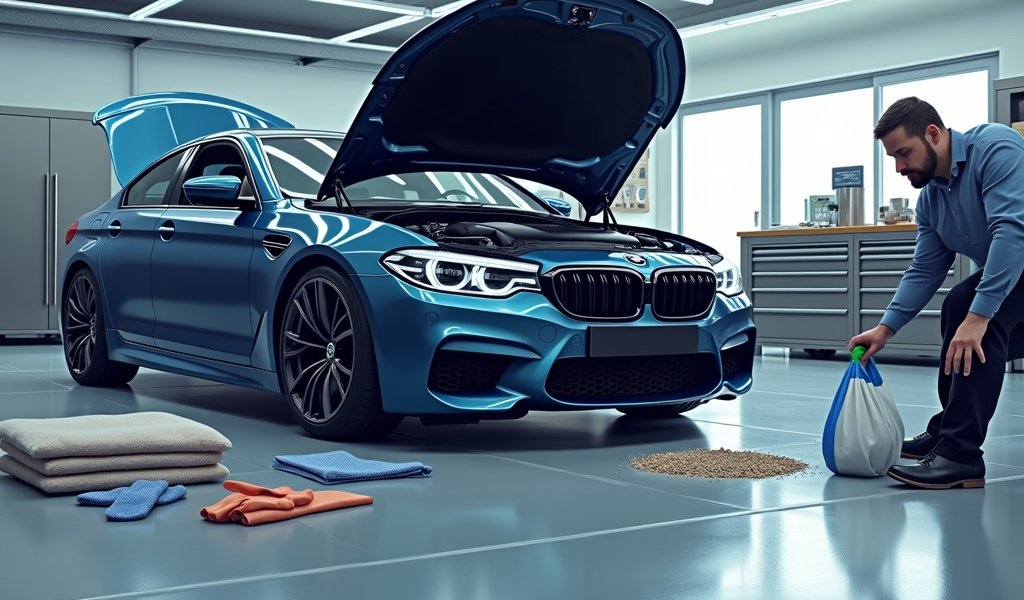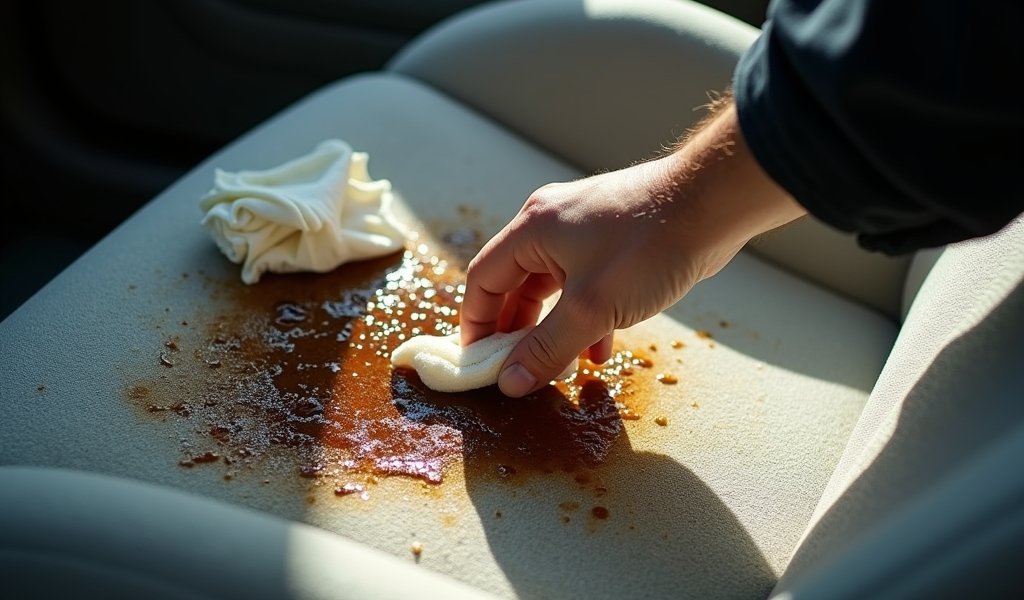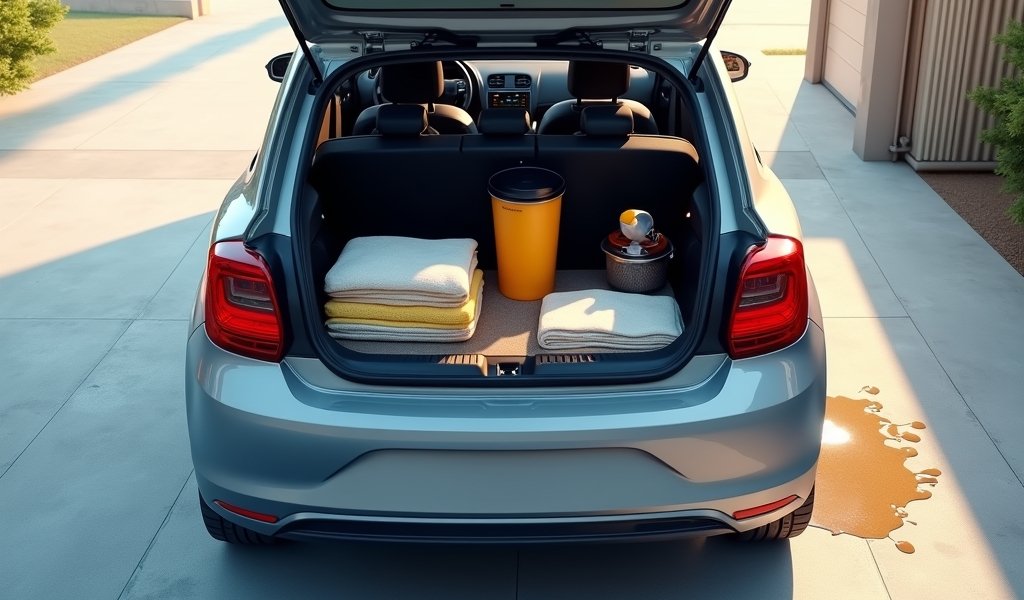Overview
This article provides seven practical tips for creating and using an emergency car spill cleanup kit, emphasizing quick response, appropriate cleaning techniques for different surfaces and substances, and regular maintenance of supplies. The guide details essential components to include in your kit, how to handle specific types of spills, and storage recommendations to ensure your cleanup supplies are always accessible when needed.
Table of Contents
- Why You Need an Emergency Car Spill Cleanup Kit
- Essential Components for Your Emergency Car Spill Cleanup Kit
- Tip 1: Quick Response is Key
- Tip 2: Know Your Surfaces
- Tip 3: Proper Spill Containment Techniques
- Tip 4: Dealing with Different Types of Spills
- Tip 5: Eco-Friendly Cleanup Solutions
- Tip 6: Storage and Accessibility
- Tip 7: Regular Maintenance of Your Cleanup Kit
- Building Your Own Custom Emergency Car Spill Cleanup Kit
- Conclusion
- Frequently Asked Questions
Why You Need an Emergency Car Spill Cleanup Kit
Let’s face it—spills happen. Whether it’s your morning coffee sloshing over during that sudden stop, your kid’s juice box exploding in the back seat, or even more concerning fluids leaking under the hood, having an emergency car spill cleanup kit can be a real lifesaver. As someone who’s spent 20+ years working on vehicles, I’ve seen how quickly a simple spill can become a permanent stain or even damage your vehicle’s interior components.
The beauty of an emergency car spill cleanup kit is that it puts everything you need right at your fingertips when disaster strikes. This isn’t just about convenience—it’s about protecting your investment. That beautiful leather upholstery or meticulously maintained dashboard doesn’t stand a chance against a hot coffee spill if left to set for hours while you hunt down cleaning supplies.
In my experience, most car owners don’t realize how crucial immediate response is until they’re dealing with a set-in stain that refuses to budge, no matter how much elbow grease they apply. What if I told you that with the right emergency car spill cleanup kit and a few proven techniques, you could handle almost any in-car disaster like a pro? That’s exactly what we’re going to cover today.
Essential Components for Your Emergency Car Spill Cleanup Kit
A well-stocked emergency car spill cleanup kit doesn’t need to be complicated, but it should be comprehensive. Here’s what I recommend including based on years of hands-on experience:
- Absorbent microfiber towels (at least 4-6)
- A pack of high-quality paper towels
- Spill-absorbing granules (like those used for pet accidents)
- Small hand-held vacuum (battery-operated)
- All-purpose interior cleaner (preferably in a travel size)
- Specialized spot removers for coffee, grease, and food stains
- A spray bottle with clean water
- Disposable gloves (nitrile is best)
- Small garbage bags for containing soiled materials
- Upholstery brush with soft bristles
The key to an effective emergency car spill cleanup kit is balancing comprehensiveness with compactness. Everything should fit in a small container that can be easily stored in your trunk or under a seat. I recommend using a water-resistant container with a secure lid—the last thing you want is your cleanup supplies getting wet or spilling themselves!
For those concerned about removing stubborn stains from car seats, include a specialized stain remover in your kit. These products are formulated specifically for automotive upholstery and can make a world of difference when dealing with tough spills.

Tip 1: Quick Response is Key
When it comes to spills in your vehicle, time is truly of the essence. The longer a liquid sits on your upholstery, carpeting, or other surfaces, the more likely it is to become a permanent reminder of that unfortunate moment. I’ve seen countless customers come in with stains that could have been prevented with immediate action.
As soon as a spill occurs, pull over safely if you’re driving. Blotting should be your first move—never rub or scrub at fresh spills as this can force the liquid deeper into the material. Use your absorbent microfiber towels and gently press down to soak up as much liquid as possible. Work from the outside of the spill inward to prevent spreading.
For larger spills, especially on carpeted areas, your absorbent granules can be a game-changer. Sprinkle them liberally over the affected area and allow them to do their magic for a few minutes before vacuuming them up. According to Consumer Reports’ interior care guide, you should aim to address spills within the first 30 seconds to two minutes for best results.
Tip 2: Know Your Surfaces
Different surfaces in your vehicle require different cleaning approaches. What works beautifully on your vinyl flooring might damage your leather seats or electronic displays. As a professional, I’ve seen too many well-intentioned cleanup attempts go wrong because the wrong product was used on a sensitive surface.
For leather upholstery, less is more. Use the minimal amount of cleaning solution necessary, and always follow with a leather conditioner if you have it available (this could be a worthwhile addition to your emergency car spill cleanup kit if you have leather interiors). Cloth upholstery is more forgiving but can absorb liquids quickly, making fast response crucial.
Dashboard surfaces, particularly those with screens or electronic controls, should be treated with extreme caution. Use only a very slightly dampened microfiber cloth for these areas, and never spray cleaning solutions directly onto electronic components. For stubborn coffee spills on your car’s interior, specialized cleaners designed for automotive use are your best bet.
Tip 3: Proper Spill Containment Techniques
Before diving into full cleanup mode, containing the spill properly can save you a lot of headaches. If you’ve ever watched a small coffee spill migrate across your entire center console while scrambling for napkins, you’ll appreciate these containment strategies.
For liquid spills on flat surfaces, create a “dam” with microfiber towels or paper towels to prevent spreading. Place them around the perimeter of the spill, then work on absorbing from the edges toward the center. For upholstered surfaces where liquids can seep downward, apply gentle pressure with an absorbent cloth directly on top of the spill, replacing the cloth as it becomes saturated.
When dealing with sticky substances like soda or juice, avoid the temptation to wipe immediately. Instead, use a plastic card (like an old gift card) to gently scrape away as much of the substance as possible before blotting. This prevents smearing the sticky residue across a larger area.
For powdery spills like dirt, sand, or even spilled snacks, your hand-held vacuum is your first line of defense. Vacuum thoroughly before introducing any moisture, which could create a paste that’s harder to remove. This is especially important for families who often deal with protecting car interiors from children’s food spills.
Tip 4: Dealing with Different Types of Spills
Not all spills are created equal. The approach for cleaning up spilled water differs dramatically from tackling grease or red wine. Here’s how to handle some of the most common culprits:
Coffee and Tea Spills
These caffeine carriers contain tannins that can set quickly. After blotting up excess liquid, apply a solution of equal parts white vinegar and cool water. For stubborn stains, a specialized coffee stain remover is worth its weight in gold. Don’t use hot water, as it can set the stain permanently.
Grease and Oil
Whether it’s from fast food or car maintenance, grease needs special attention. Sprinkle corn starch or baby powder on the area to absorb the oil before vacuuming it away. Follow with an automotive degreaser specifically designed for interior surfaces. Avoid water-based products initially as they can spread the grease.
Sticky Beverages
Soda, juice, and sports drinks are not only sticky but often contain dyes. After blotting, clean with a mixture of mild dish soap and cool water. For carpet and upholstery, use as little liquid as possible and extract thoroughly with dry cloths. A portable fabric cleaner can be invaluable for these situations.
Bodily Fluids
For pet accidents, motion sickness, or other biological spills, prioritize sanitization. Use an enzymatic cleaner that breaks down proteins, followed by a disinfectant approved for automotive interiors. Always wear gloves when handling these spills, and dispose of cleaning materials properly.

Tip 5: Eco-Friendly Cleanup Solutions
If you’re environmentally conscious or sensitive to harsh chemicals, your emergency car spill cleanup kit can still be highly effective with green alternatives. I’ve found that many natural solutions work just as well as their chemical counterparts, often with the added benefit of leaving your car smelling fresh rather than like a cleaning supply closet.
White vinegar diluted with water (1:1 ratio) makes an excellent all-purpose cleaner for most surfaces. For deeper cleaning, a paste of baking soda and water can work wonders on stubborn stains when allowed to sit for a few minutes before blotting away. These natural options are particularly good for families with young children or pets who might come into contact with the cleaned surfaces.
Consider adding a small bottle of castile soap to your kit – it’s biodegradable, gentle on surfaces, and incredibly versatile. According to EPA guidelines on reducing vehicle pollution, using environmentally friendly cleaning products helps minimize your overall environmental impact beyond just fuel consumption.
Tip 6: Storage and Accessibility
The most comprehensive emergency car spill cleanup kit in the world is useless if you can’t reach it when disaster strikes. Strategic storage is essential for quick access during those panicked moments after a spill.
I recommend storing your kit in a consistent, easily accessible location. The rear cargo area works well for SUVs and hatchbacks, while a dedicated spot under the passenger seat might be better for sedans. Whatever location you choose, make sure everyone who regularly drives your vehicle knows exactly where to find it.
Consider the climate in your region when selecting storage. Extreme temperatures can affect cleaning solutions, so avoid trunk storage in very hot or cold climates. Instead, opt for interior storage where temperature fluctuations are less severe. A waterproof container is non-negotiable—the last thing you want is leaking cleaning solutions creating a bigger mess than the one you’re trying to fix.
For families with children, keeping a mini version of your emergency car spill cleanup kit in the back seat area can be a lifesaver. A simple zippered pouch with a few essentials can handle those juice box disasters before they have a chance to set in.
Tip 7: Regular Maintenance of Your Cleanup Kit
Like any emergency preparation, your car spill cleanup kit needs regular attention to remain effective when you need it most. I’ve seen too many car owners reach for their kit during a crisis only to find dried-out wipes or empty bottles.
Set a calendar reminder to check your kit every three months. Replenish any supplies that are running low, ensure spray bottles haven’t leaked, and verify that battery-operated items like mini-vacuums are still functioning. Replace microfiber towels that have become stiff or less absorbent over time.
Pay special attention to liquid cleaning products, which can separate or lose effectiveness over time, especially if stored in extreme temperatures. Most cleaning solutions have a shelf life of 1-2 years, but this can be shortened by environmental conditions. When in doubt, replace rather than risk ineffective cleaning when you need it most.
If you’ve recently used your kit, make restocking it your top priority before your next drive. The peace of mind knowing you’re prepared for the next inevitable spill is well worth the small effort of maintenance.
Building Your Own Custom Emergency Car Spill Cleanup Kit
While pre-assembled emergency car spill cleanup kits exist on the market, building your own allows you to customize it to your specific vehicle and lifestyle needs. As a mechanic who’s seen thousands of different spill scenarios, I can tell you that personalization matters.
Start with a suitable container—a plastic toolbox with compartments, a dedicated cleaning caddy, or even a repurposed first aid kit works well. The key is having something sturdy, water-resistant, and appropriately sized for your vehicle’s storage areas.
Consider your vehicle’s interior materials when selecting cleaning products. Leather seats need different care than cloth upholstery. If you have children or pets who regularly ride along, prioritize non-toxic cleaning solutions and include extra absorbent materials for inevitable accidents.
Don’t forget seasonal considerations—summer road trips might mean more beverage spills and melted ice cream disasters, while winter brings salt, slush, and coffee spills as you try to stay warm. Adjust your kit’s contents accordingly as the seasons change. According to AAA’s auto repair experts, seasonal maintenance of your car’s interior can significantly extend its lifespan and preserve its value.
Conclusion
An emergency car spill cleanup kit isn’t just a convenience—it’s an investment in preserving your vehicle’s condition and value. With these seven tips and a well-stocked kit at your disposal, you’ll be prepared to tackle virtually any spill situation that comes your way, from minor coffee drips to major smoothie disasters.
Remember that the most effective approach combines quick action, appropriate cleaning methods for different surfaces and substances, and regular maintenance of your supplies. By following the guidance outlined in this article, you’ll be able to handle spills with confidence and keep your vehicle looking and smelling its best for years to come.
The peace of mind that comes from knowing you’re prepared for the unexpected is invaluable. So take some time this weekend to assemble your personalized emergency car spill cleanup kit. Your future self—frantically trying to clean up that tipped travel mug or exploded pen—will thank you profusely!
Frequently Asked Questions
What are the most essential items for a basic emergency car spill cleanup kit?
The most essential items are microfiber towels, absorbent granules, all-purpose cleaner, and disposable gloves. This minimal setup will handle most common spills effectively.
How often should I replace items in my emergency car spill cleanup kit?
Check your kit every three months and replace liquid cleaners annually or if they show signs of separation. Microfiber towels should be replaced when they become stiff or less absorbent.
Can I use household cleaners in my car spill kit?
Many household cleaners are too harsh for automotive interiors and can damage surfaces. Stick to cleaners specifically formulated for automotive use or gentle alternatives like diluted vinegar.
What’s the best way to handle coffee spills on car upholstery?
Blot immediately with absorbent cloths, then clean with a specialized coffee stain remover or a mixture of vinegar and water. Never use hot water, as it can set the stain permanently.
Where’s the best place to store my emergency car spill cleanup kit?
Store your kit in a consistent, easily accessible location like under the passenger seat or in a side compartment. Avoid trunk storage in extreme climates, as temperature fluctuations can affect cleaning solutions.


Pingback: How to clean food spills in car: 3 Steps - knowsyourcar.com